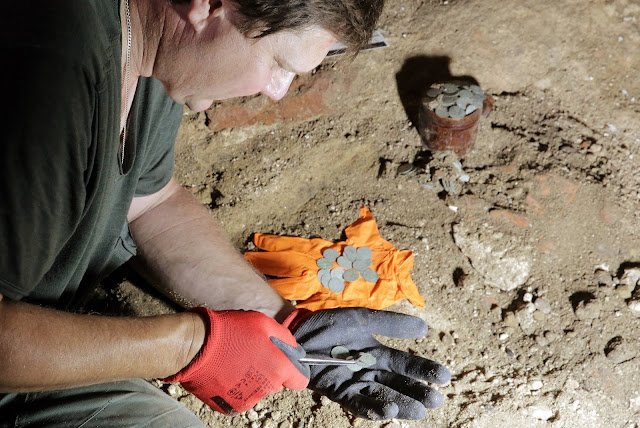A treasure trove of 17th century silver coins has been found under the floor of a monastic church. Archaeologists from the University of Gdansk were working in the presbytery of the 14th century Church of the Saint Andrew the Apostle in the town of Barczewo in Poland’s northern province of Warmia, when they discovered a glazed ceramic mug handle filled with nearly 1,000 coins. Coins were also scattered around the vessel.
 |
| Archaeologists from the University of Gdansk discovered a glazed ceramic mug handle filled with nearly 1,000 coins [Credit: Tomasz Waszczuk/PAP] |
The coins are silver and were struck for the Polish royal crown and bear the image of King Sigismund III Vasa’s long reign (1587-1632). The find is made up mainly of lower denomination Polish coins, and includes groschens, 1.5 groschens, as well as 3 and 6 groschen coins. The haul includes many Prussian shillings struck for Prince George Wilhelm Hohenzollern, who was a fief of the Republic of Poland, as well as Lithuanian coins.
 |
| The find is made up mainly of lower denomination Polish coins, and includes groschens, 1.5 groschens, as well as 3 and 6 groschen coins [Credit: Tomasz Waszczuk/PAP] |
Dr Koperkiewicz says that the coins were hidden at the time when the Bernardine monastery flourished in the 17th century, when the Order received numerous subsidies from the Warmian bishops. However, it remains a mystery why the coins were placed where they were and why they remained hidden until today.
 |
| Dr. Koperkiewicz, the archaeologist leading the work, believes that the treasure was placed under the floor in the chancel of the church by the monks themselves [Credit: Tomasz Waszczuk/PAP] |
The interior of the church is currently undergoing preparatory work to strengthen the earth under the foundations of the church. The Church of St. Andrew the Apostle was built at the same time as Franciscan monastery at the end of the 14th century by the Teutonic Order.
 |
| The interior of the church is undergoing preparatory work to strengthen the earth under the foundations of the church [Credit: Tomasz Waszczuk/PAP] |
The Bernardines remained in Barczewo until 1810, when they were abolished by the Prussian authorities. After World War II, the Franciscans returned to Barczewo and regained the church of St. Andrew the Apostle.
 |
| Though covered in dirt and needing a good clean after their 400-year hibernation, the experts from Gdansk said that the coins are relatively well-preserved [Credit: Tomasz Waszczuk/PAP] |
Przemyslaw Gorek, head of conservation at Gorek Restauro, the general contractor, told PAP: “We will do everything in our power to make sure that the treasure can be exhibited here in the Church in a specially arranged exhibition space.”
Author: Stuart Dowell | Source: The First News [August 06, 2019]







No comments: